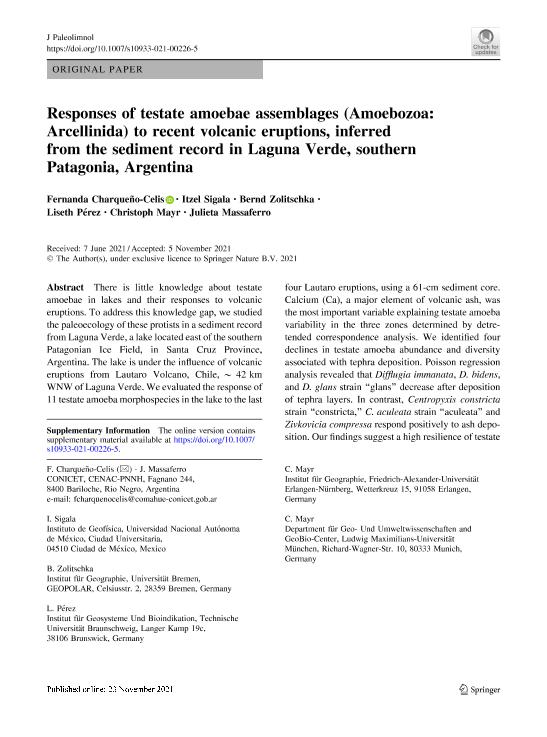Mostrar el registro sencillo del ítem
dc.contributor.author
Charqueño Celis, Norma Fernanda

dc.contributor.author
Sigala, Itzel
dc.contributor.author
Zolitschka, Bernd

dc.contributor.author
Pérez, Liseth
dc.contributor.author
Mayr, Christoph

dc.contributor.author
Massaferro, Julieta

dc.date.available
2022-03-10T13:01:48Z
dc.date.issued
2021-11
dc.identifier.citation
Charqueño Celis, Norma Fernanda; Sigala, Itzel; Zolitschka, Bernd; Pérez, Liseth; Mayr, Christoph; et al.; Responses of testate amoebae assemblages (Amoebozoa: Arcellinida) to recent volcanic eruptions, inferred from the sediment record in Laguna Verde, southern Patagonia, Argentina; Springer; Journal Of Paleolimnology; 67; 2; 11-2021; 115-129
dc.identifier.issn
0921-2728
dc.identifier.uri
http://hdl.handle.net/11336/153165
dc.description.abstract
There is little knowledge about testate amoebae in lakes and their responses to volcanic eruptions. To address this knowledge gap, we studied the paleoecology of these protists in a sediment record from Laguna Verde, a lake located east of the southern Patagonian Ice Field, in Santa Cruz Province, Argentina. The lake is under the influence of volcanic eruptions from Lautaro Volcano, Chile, ~ 42 km WNW of Laguna Verde. We evaluated the response of 11 testate amoeba morphospecies in the lake to the last four Lautaro eruptions, using a 61-cm sediment core. Calcium (Ca), a major element of volcanic ash, was the most important variable explaining testate amoeba variability in the three zones determined by detretended correspondence analysis. We identified four declines in testate amoeba abundance and diversity associated with tephra deposition. Poisson regression analysis revealed that Difflugia immanata, D. bidens, and D. glans strain “glans” decrease after deposition of tephra layers. In contrast, Centropyxis constricta strain “constricta,” C. aculeata strain “aculeata” and Zivkovicia compressa respond positively to ash deposition. Our findings suggest a high resilience of testate amoebae to stochastic events such as volcanism because the same assemblage (D. immanata, D. bidens, and D. glans strain “glans”) inhabited the lake before and after the ashfalls. Nevertheless, several volcanic eruptions during the last ~ 300 years may have weakened this resilience and had a long-term effect on community diversity. Multivariate analysis showed that potassium (K) plays a significant role in shaping assemblage composition. Because of the low K content of the Lautaro tephra, we infer that higher potassium concentrations in sediments are not related with volcanic events, but rather, are associated with terrestrial input. Future studies, however, will be needed to identify the source of K in the sediment record and its relationship with testate amoebae assemblages. Our study demonstrates the potential for using lacustrine testate amoebae as environmental proxies, and illustrates the direct effects of volcanic ash deposition on their assemblage composition, diversity and distribution in southern Patagonia.
dc.format
application/pdf
dc.language.iso
eng
dc.publisher
Springer

dc.rights
info:eu-repo/semantics/openAccess
dc.rights.uri
https://creativecommons.org/licenses/by-nc-sa/2.5/ar/
dc.subject
BIOINDICATORS
dc.subject
GEOCHEMISTRY
dc.subject
NORTHERN AUSTRAL VOLCANIC ZONE
dc.subject
PALEOECOLOGY
dc.subject
PATAGONIAN LAKES
dc.subject
PROTISTS
dc.subject
TEPHRA
dc.subject
TEPHROPALEOECOLOGY
dc.subject
VOLCANIC IMPACT
dc.subject.classification
Biología Marina, Limnología

dc.subject.classification
Ciencias Biológicas

dc.subject.classification
CIENCIAS NATURALES Y EXACTAS

dc.title
Responses of testate amoebae assemblages (Amoebozoa: Arcellinida) to recent volcanic eruptions, inferred from the sediment record in Laguna Verde, southern Patagonia, Argentina
dc.type
info:eu-repo/semantics/article
dc.type
info:ar-repo/semantics/artículo
dc.type
info:eu-repo/semantics/publishedVersion
dc.date.updated
2022-03-08T22:03:22Z
dc.journal.volume
67
dc.journal.number
2
dc.journal.pagination
115-129
dc.journal.pais
Alemania

dc.journal.ciudad
Berlín
dc.description.fil
Fil: Charqueño Celis, Norma Fernanda. Consejo Nacional de Investigaciones Científicas y Técnicas. Centro Científico Tecnológico Conicet - Patagonia Norte; Argentina. Administración de Parques Nacionales. Parque Nacional "Nahuel Huapi"; Argentina
dc.description.fil
Fil: Sigala, Itzel. Universidad Nacional Autónoma de México. Instituto de Geofísica; México
dc.description.fil
Fil: Zolitschka, Bernd. Universitat Bremen. Institut Fuer Geographie; Alemania
dc.description.fil
Fil: Pérez, Liseth. Technische Universitat Carolo Wilhelmina Zu Braunschweig. Iinstitut fur Geosysteme und Bioindikation; Alemania
dc.description.fil
Fil: Mayr, Christoph. Institut Fur Geographie, Friedrich-alexander-universit; Alemania. Universitat Erlangen Nuremberg; Alemania. Ludwig Maximilians Universitat; Alemania
dc.description.fil
Fil: Massaferro, Julieta. Consejo Nacional de Investigaciones Científicas y Técnicas. Centro Científico Tecnológico Conicet - Patagonia Norte; Argentina. Administración de Parques Nacionales. Parque Nacional "Nahuel Huapi"; Argentina
dc.journal.title
Journal Of Paleolimnology

dc.relation.alternativeid
info:eu-repo/semantics/altIdentifier/url/https://link.springer.com/10.1007/s10933-021-00226-5
dc.relation.alternativeid
info:eu-repo/semantics/altIdentifier/doi/http://dx.doi.org/10.1007/s10933-021-00226-5
Archivos asociados
